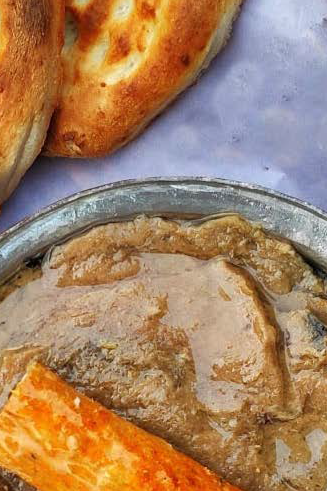As the vibrant hues of autumn paint the landscapes of Kashmir, the tradition of savoring heartwarming Harissa comes to life. The art and flavors of this beloved dish warm the bodies and souls of its enthusiasts.
By Rehan Qayoom Mir
As the picturesque golden hues of autumn gradually start their enchanting sweep across the breathtaking landscapes of Kashmir, people of this region eagerly embrace the cherished tradition of savoring hearty, steaming bowls of Harissa, a mouthwatering delicacy that warms not only the body but also the very essence of the soul. Autumn’s Arrival in Kashmir: Harissa Craze Takes Hold
Harissa, an exquisite slow-cooked dish renowned for its unparalleled blend of flavors and captivating textures, typically features succulent, painstakingly slow-cooked meat, often the tender mutton, harmoniously melded with a creamy mixture of rice and wheat grains.
For generations, the people of this pristine valley have harbored a profound and enduring affection for the delectable Harissa. As the mercury steadily drops, and the impending winter inches ever closer, the fervor and craze for Harissa gain momentum, becoming a culinary hallmark of the valley’s seasonal transition.
Likewise, in the bustling, vibrant markets of the picturesque Srinagar and other towns that dot the region’s map, the alluring Harissa stalls cast their irresistible spell on both locals and the stream of tourists alike. The sight of these fragrant stalls, where the rich, aromatic Harissa is ladled into artisanal clay pots and served with traditional flatbreads, has become a quintessential and inseparable facet of the Kashmiri autumn experience.

In conversation with locals and the dedicated Harissa vendors who diligently carry on this gastronomic tradition, they shared their memorable insights into the art of crafting this cherished dish.
“The preparation of Harissa is a true culinary art in itself, demanding a great deal of patience and skill. Mutton is slow-cooked overnight in colossal copper pots, stirred with meticulous precision to attain the perfect, desired consistency. The rice and wheat are then gradually incorporated, transforming the concoction into a silky, porridge-like masterpiece,” stated Sameer Dagloo, a venerable Harissa purveyor based in the charming Rambagh of Srinagar.
Another seasoned Harissa seller, hailing from Srinagar’s bustling downtown, shared, “Harissa is not just a dish; it’s a labor of love and a timeless tradition. The painstaking, slow-cooking process allows us to infuse the very warmth of Kashmir into every bowl, making it not just a dish but a symbol of our culture and the shifting seasons.”
Similarly, locals, whom we had the privilege to speak with, emphasized that as the autumn leaves gracefully descend and the air turns crisper, there exists nothing more heartwarming and comforting than the cherished tradition of coming together with family and friends over a steaming, aromatic bowl of Harissa. It’s not just a taste of home but a taste of Kashmir itself and, above all, a taste of unity and togetherness.

“Harissa isn’t merely sustenance; it’s a piece of our heritage, and it radiates warmth into our souls during the chilly Kashmiri winters. The sight of Harissa stalls adorning the bustling markets of Srinagar is an integral and treasured part of our autumn experience,” exclaimed Burhan Nazir, yet another local resident hailing from Rainawari in Srinagar.
Remarkably, the origins of Harissa trace back to the 14th century when the revered Sufi saint, Mir Syed Ali Hamdani (RA), arrived in Kashmir from Persia, modern-day Iran. He brought with him the cherished recipe, and the name “Harissa” derives from the Arabic word ‘Harasa,’ signifying the delicate process of mashing or crushing, a fitting homage to the meticulous preparation of this beloved dish.

Leave a Reply